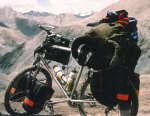There are bicycle trips that are pleasant, light-hearted vacations, such as spending a week rolling leisurely through Provence or along the Rhine. There are those which are much more work, such as cycling across Canada. And then there are those which are adventures and expeditions.
It was this sort of trip that my sisters, Audie and Saakje, and I wanted when we made plans for a family bicycle trip for the summer of 1998. Having been to Pakistan the year before, I recommended cycling the Karakoram Highway from Pakistan to China, and Saakje, who had been thinking of doing this for years, was keen to agree.
The expedition soon gained Saakje and Audie’s respective partners, Luke and Serge, and over the winter, we added the idea of continuing from Kashgar, China on to Lhasa, Tibet. We set a rendezvous for mid-May in the Tourist Campground in Islamabad; Serge, tied down by university exams, would not be able to join us until partway through the trip. We spent a few days in Islamabad getting Chinese visas, stocking up on supplies and having our first stomach troubles of the trip.
We set off from Islamabad on May 22nd, freshly-issued Chinese visas in hand. The first few days of cycling through the Punjab plains in the pre-monsoon heat were horrible. The traffic along the Grand Trunk Road, the old Mughal imperial road that leads from Delhi via Lahore and Islamabad, was hellish. We rode in a torrent of juggernaut trucks, belching diesel fumes and tooting ear-splitting, cacophonous air horns, with kamikaze minibuses speeding madly around the trucks and frequently running us off the road. The temperatures hovered around 42 degrees Celsius every day, and dehydration became a problem; the 10 litres of water, on top of 5 to 10 bottles of pop, that we guzzled daily was not enough to slake our thirst. Audie had chronic dysentery and wasted away visibly from day to day.
When we turned off the Grand Trunk Road and headed north towards Mardan, the traffic eased but we were hindered greatly by flat tires caused by tiny thorns that easily punctured our heat-softened tires. On our worst day, we had 15 separate flat tires. When we stopped to fix the punctures, we found that the blistering heat given off by the asphalt had melted our inner tubes to the tires.
The only compensation for this miserable cycling was the chance to poke around ancient Buddhist ruins at Taxila, Jamal Garhi and Takht-I-Bahi. It was a relief to leave the bikes and walk through ruined monasteries, some of them 2000 years old, spread picturesquely over the rocky hillsides and the fertile plains, and to contemplate the broad sweep of history that lingered along this branch of the ancient Silk Road.
![]()

![]()
We were carrying a huge amount of luggage: cold-weather gear and backpacks for the mountains, plenty of medicine and cooking gear, and a large weight of spare parts and tools. Our luggage racks began to groan under their loads. First Luke and then I had a series of mishaps with our racks, bending them and snapping the screws that held them to the bicycles.
On the way from Takht-i-Bahi to Chakdarra, a screw holding my front luggage rack snapped off and we couldn’t remove the broken piece from the fork. It was repaired, expertly and free of charge, by a family of local feudal landlords and gun merchants, who rescued us from a curious, helpful but annoying mob clustered around us by the side of the road. They served us a magnificent lunch and showed us their vast collection of imitation M-16s and Kalashnikovs, manufactured in the tribal areas of Pakistan’s Northwest Frontier Province. We passed the arsenal around and posed casually with rifles in our hands until we suddenly realized that they were loaded; we handed our toys back again very carefully.
Questions?
If you want more information about this area you can email the author or check out our Asia Insiders page.
![]()